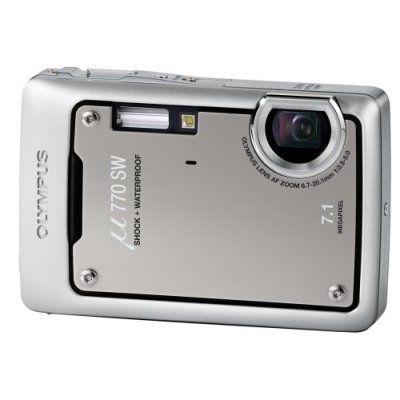Hard on the heels of the recently tested Olympus Mju 725SW comes the latest in the company's ruggedised compact range, the 770SW. Olympus says it is: “the world’s first compact camera that’s waterproof to 10m, shockproof against falls from up to 1.5m and freezeproof to -10 degrees Celsius. What’s more, this rock-solid wonder is also crushproof to an unbelievable 100kg!”.
Our quick take
Olympus is renowned for its weatherproofed compacts and its SW series of digital compacts extend that “proofing” to greater depths and strengths than ever before with the Mju 770SW.
Picture quality is good at the Super High Quality and at lower ISO settings. Ease of use (under “normal” conditions at least) is built-in, but the lack of any real manual control other than +/-2EV exposure compensation means anyone looking for more control might want to steer clear.
However, those of you looking for a rugged, pocketable, yet stylish outdoor camera that can practically (and literally) go (almost) anywhere, then look no further.

Olympus Mju 770SW digital camera - 4.5 / 5
| FOR | AGAINST |
|---|---|
|
|
So the 770 boosts the rugged good looks of the 725 but with increased waterproofing to 10-metres (that’s over 30 feet). The camera’s drop proofing is the same as the 725’s at 1.5-metres but now the all-metal bodywork features crush proofing to 100kg. A nice side benefit of all this protection is the camera is dust proofed out of the box. The low temperature capability is excellent as well but it remains to be seen how it affects battery life, batteries and low temperatures don’t mix.
Nevertheless, this is truly a camera either for the dynamic outdoorsy type or for a family where they know the camera is going to get fully used by all the family when out and about or just knocking around the garden or indoors.
The 770’s 7.1-megapixel sensor is the same as that from the 725 and it is pleasing Olympus resisted the temptation to cram in more pixels; the image quality from the 725 is repeated here. Styling, ergonomics and handling are all good although I can’t help thinking, the small controls and buttons will be a challenge for a diver wearing gloves in the gloom at 30-feet underwater, so pre-setting the camera is probably the answer, but this limits the usability at depth or when wearing gloves in the cold or example.
Having said that the control layout is logical and although the buttons are small, they’re nicely raised but still not quite enough, I feel. However, as a true outdoors adventure style camera the 770 the svelte, lightweight, all-metal body makes it great to carry around and to look at. I note however, the neoprene carry case included with the 725 is not included in this camera’s kit.
The 3x optical zoom lens is the same as on the 725 with a 38-114mm focal range so fairly standard fair for this level of camera but good enough for most tasks. The super macro close focus distance of 2.8-inches is good but the addition of a small, angled, auxiliary LED lamp to illuminate small subjects that would normally be to far from the built in flash to be properly illuminated at such close distances, is a stoke of genius. The camera’s white balance in this mode is automatically adjusted for the LED lamp too.
The Digital ESP metering, white balance control (with the usual array of presets for tungsten, fluorescent daylight and shade), colour and focusing all work very well but the same problems around high ISO image noise and noise reduction processing that can remove detail from images.
The BrightCapture technology automatically helps boost the LCD brightness and the image vibrancy and works well enough. However, a good ISO range runs from ISO 80 to ISO 1600; ISO’s up to 200 produce images where noise is well controlled and detail retained. Over ISO 400, things drop off and beyond ISO 800, noise becomes a real issue compounded by detail smoothing from noise processing within the camera.
24 scene modes include, appropriately enough, four underwater settings (providing two wide-angle modes, an underwater macro shooting mode and, helpfully, an underwater snapshot setting where the focus is fixed), plus the more usual settings such as portrait, landscape, beach and snow modes and a sport mode among others.
To recap
Another Tonka-tough compact from Olympus that is both tougher and more waterproof than the camera before it
